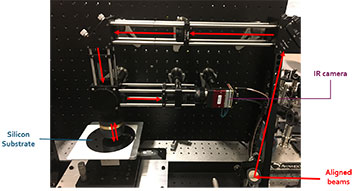Researchers developed a new way to use femtosecond laser pulses to fabricate the high-precision ultrathin mirrors required for high-performance x-ray telescopes. Femtosecond laser surface ablation is applied to selectively remove stressed film regions on the mirror substrate, correcting the shape of the mirror’s reflective surface. [Image: H. Zuo, MIT Kavli Institute for Astrophysics and Space Research] [Enlarge image]
When the next generation of space-based astronomical observatories launches in the 2030s, the new telescopes will need state-of-the-art optics to improve upon the current generation of spacecraft. A new laser micromachining technique for shaping surfaces could sharpen future mirrors for spaceborne X-ray telescopes.
Researchers at a US laboratory used femtosecond laser pulses to modify the stress states of thin-shell silicon mirrors for collecting X-rays (Optica, doi: 10.1364/OPTICA.461870). The method could improve the optical quality and resolution of future space-based observing missions.
X-ray observatories
X-rays from space, which originate in extremely hot gases, cannot be seen through Earth’s atmosphere, so telescopes must get above the atmosphere to detect them. Professional astronomers have two workhorse spacecraft, NASA’s Chandra X-ray Observatory and the European Space Agency’s XMM-Newton, but both instruments were launched back in 1999. The two space agencies are working on plans for upgraded X-ray telescopes to be launched in the next decade or two.
Conventionally shaped telescopes—from ground-based behemoths to the Hubble and James Webb space telescopes—do not catch high-energy photons very well; incoming X-rays must be focused with glancing reflection off a series of highly reflective paraboloid or hyperboloid mirrors.
Precision bending and stress mapping
NASA’s current concept for a next-generation X-ray observatory—named Lynx, to be launched no earlier than 2036—calls for more than 37,000 lightweight, thin-shell silicon mirrors. However, such mirrors bend out of shape easily during the fabrication process or the coating process.
To keep mirrors steady during manufacturing, Heng Zuo and her colleagues at the Massachusetts Institute of Technology (MIT) Kavli Institute for Astrophysics and Space Research, USA, applied a method known as stress-based figure correction. In this technique, small bits of the mirror substrate are either locally stressed or completely removed from strategic regions of the mirror to encourage the material to curve properly.
The experimental setup combines femtosecond laser micromachining with a previously developed technique called stress-based figure correction. Red arrows show the light path through the setup. [Image: H. Zuo, MIT Kavli Institute for Astrophysics and Space Research] [Enlarge image]
For the current study, Zuo coated the back (non-reflective) side of the mirrors with the thermal oxide of silicon. Next, she used a femtosecond pulsed laser to create tiny holes and troughs, with dimensions of roughly 10 μm, in the SiO2 substrate. “The removal of the stressed film and the relaxation of adjacent substrate regions together contribute to further stress relaxation and substrate bending,” the authors wrote.
To improve the stress-figuring process, the MIT team developed a multi-pass correction scheme, incorporating a feedback loop to repeat the micromachining process until the mirror has been shaped into the correct profile.
Correcting for “any type of error”
“Our experimental results showed that patterned removal of periodic holes leads to equibiaxial (bowl-shaped) stress states, while fine-pitched oriented removal of periodic troughs generates non-equibiaxial (potato-chip-shaped) stress components,” said Zuo, who is now with the University of New Mexico, USA, in a press release. “[Through] combining these two features with proper rotation of the trough orientation, we can create a variety of stress states that can, in principle, be used to correct for any type of error in the mirrors.”


